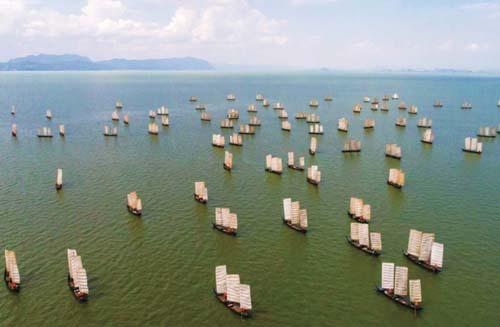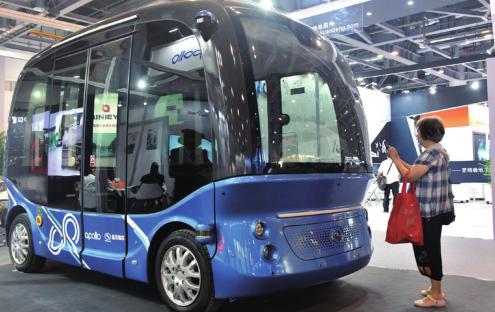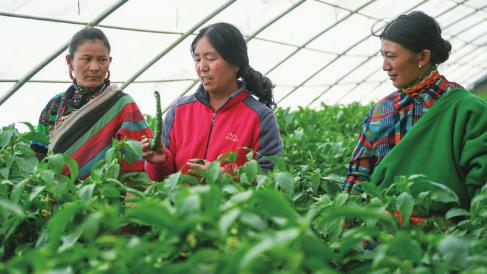Fishing Harvest Commences
Fishing boats sail on Dianchi Lake in Kunming, southwest Chinas Yunnan Province, on September 23, as the fi shing season recently began.
Budget Performance Evaluation
China aims to build an allencompassing budget performance evaluation system in three to fi ve years, according to a statement released on September 25.
The Central Committee of the Communist Party of China and the State Council issued a regulation regarding the decision to introduce the system. This marks a key step in expanding the countrys fi scal and tax reform and upgrading governance and budget management.
Under the regulation, the budget performance evaluation will be more “comprehensive,” covering revenue and expenditure of govern- ments at all levels.
The evaluation aims to cover the entire process, from establishing a performance evaluation mechanism to strengthening performance appraisal monitoring.
The regulation also underlines the application of the evaluation results. A third-party institution could be introduced to help with the performance assessment independently if required. The audit and evaluation results will be a major indicator for future budget planning.
The evaluation will apply to budgets pertaining to general public fi nance, government-managed funds, state capital operations and social insurance investments.
The regulation also highlights the duty of local governments. Heads in charge of key projects will take lifelong responsibility for the budget performance.
BeiDou Improvement
Chinas BeiDou navigation satellites will provide danger alerts and navigation services for global users after the successful launch of two satellites on September 19.
The twin BeiDou-3 navigation satellites were sent into space on a single carrier rocket, Long March-3B, from the Xichang Satellite Launch Center at 10:07 p.m. It was the 285th mission of the Long March rocket series.
The twin satellites are the 37th and 38th editions of the BeiDou navigation satellites. After a series of tests and evaluations, they will work together with the 12 BeiDou-3 satellites already in orbit.
China will have BeiDou operating as a medium-orbit rescue system with the launch of the two satellites. They will provide danger alerts and navigation services for users at sea, on land and in the air. The rescue payload on the two satellites will improve the alarm forwarding effi ciency and help safeguard peoples lives.
In February, the BeiDou system was listed on a global satellite search and rescue implementation plan by COSPAS-SARSAT, an international satellite system for search and rescue.
In the future, the BeiDou navigation system will be able to send feedback information to people in danger, notifying them that their calls were received.
A basic system with 18 orbiting BeiDou-3 satellites will be in place by the end of the year. Named after the Chinese term for the Big Dipper, the BeiDou system began serving China in 2000 and the Asia-Pacifi c region in 2012.
Arms Sales Opposition
A spokesperson for the Chinese military said that it was strongly dissatisfi ed with, and resolutely opposed, the planned U.S. arms sales to Taiwan.
“The Chinese military lodges solemn representations to the U.S. side over the move,” said Ren Guoqiang, spokesperson for the Ministry of National Defense.
Rens comment came after the U.S. Government informed Congress of its decision to sell weapons worth about $330 million to Taiwan on September 25.
“Taiwan is a part of China and the one-China principle is the political foundation of the China-U.S. relationship,” Ren said.
“The U.S. move has severely violated the one-China principle and regulations of three Sino-U.S.joint communiqués, interfered with Chinas domestic affairs and harmed Chinas sovereignty and security interests, and seriously damaged China-U.S. ties, relations between the two militaries, as well as peace and stability across the Taiwan Straits,”the spokesperson said.
“The Chinese militarys determination and will to safeguard Chinas sovereignty and territorial integrity are steadfast and unshakable,” Ren added. “We strongly urge the U.S. side to… immediately revoke arms sales to Taiwan, and stop military contact with Taiwan including arms sales.”
Illegal Organization
The Hong Kong and Macao Affairs Offi ce of the State Council said on September 24 it resolutely supports the Hong Kong Special Administrative Region (HKSAR) Governments ban on the so-called“Hong Kong National Party.”
The HKSAR Government has announced an order in its gazette to prohibit the operation of the“Hong Kong National Party.” A spokesperson for the offi ce said it is an unregistered and illegal group as well as a “Hong Kong independence” organization.
The HKSAR Governments decision to bar the group from operating according to relevant laws and legal procedures is an action that should be taken to maintain national security and the rule of law in Hong Kong, and is absolutely necessary, the spokesperson said.“We resolutely support the decision.”
The Central Government fi rmly supports the HKSAR in punishing any acts that jeopardize national security in accordance with the law and has zero tolerance for any organizations preaching “Hong Kong independence” or engaging in activities of splitting the country, said the spokesperson.
“We fi rmly support the HKSAR in maintaining the rule of law, banning the operation of the ‘Hong Kong National Party according to the law and performing the constitutional duty to safeguard national sovereignty, security and development interests,” an offi cial with the Liaison Offi ce of the Central Peoples Government in the HKSAR said in an interview with Xinhua News Agency.
Building Bridges
Workers pave asphalt on the surface of a bridge across the Yangtze River in Nantong, east Chinas Jiangsu Province, on September 25. The bridge, with a span of 1,092 meters, is a cable-stayed railway-expressway bridge connecting Nantong and Zhangjiagang in Jiangsu.
Sunken Shipwreck
Chinese archaeologists have found a shipwreck, confi rmed to be the warship Jingyuan, which was sunk by the Japanese navy during the SinoJapanese War (1894-95), according to the National Cultural Heritage Administration (NCHA).
The National Center of Underwater Cultural Heritage, together with archaeological research institutes from northeast Chinas Liaoning Province, found the warship after a two-month investigation near the city of Zhuanghe in Liaoning.
The underwater investigation, which ran between July and September, also found more than 500 relics made of iron, glass, porcelain, leather and other materials.
The archaeologists identifi ed the shipwreck, which was located on the seabed 12 meters underwater, on September 15.
The fi nding is of great value to research pertaining to Chinas modern history as well as the history of the navy and warfare. It also offers precious materials for research of the world history of naval ships, said Song Xinchao, deputy head of the NCHA.
Sino-Japanese naval war relics have been on the agenda of Chinese underwater archaeological researchers in recent years, with Zhiyuan, another warship sunk by the Japanese navy, found four years ago and confi rmed a year later.
Local Food Brings Prosperity
A bowl of river snail rice noodles is served at a restaurant in Liuzhou, south Chinas Guangxi Zhuang Autonomous Region, on September 20. In recent years, the promotion of river snail rice noodles has benefi ted over 4,500 impoverished households in Liuzhou.

Tariff Cuts
China will lower tariffs on some imported goods and streamline customs clearance to make the procedure faster. These are among the measures to be rolled out to expand opening up and foster a more enabling environment for foreign trade and investment.
An executive meeting of the State Council, Chinas cabinet, held on September 26, approved these and other measures. From November 1, import tariffs on 1,585 items will be slashed. By November 1, the number of customs clearance documents subject to verifi cation at ports will be reduced from 86 to 48.
The average tariff rate for products in high demand in domestic markets such as machinery and industrial instruments will be cut from 12.2 percent to 8.8 percent, textile and construction materials from 11.5 percent to 8.4 percent, paper and some other resource-based products and primarily processed goods from 6.6 percent to 5.4 percent.
The tariff cuts will help reduce corporate and consumer tax burdens by nearly 60 billion yuan ($8.7 billion) and lower Chinas overall tariff rate from 9.8 percent last year to 7.5 percent.
According to the Ministry of Commerce, paid-in foreign investment reached $86.5 billion between January and August, a 6.1-percent increase year on year.
Streamlined Investments
Chinas outbound direct investment(ODI) has seen its structure upgraded, with less irrational spending, more diverse destinations and a more effi cient strategy put in place, according to offi cial information.
In the period of January-August, the countrys ODI amounted to$74.1 billion, rising 7.8 percent year on year, Ministry of Commerce(MOFCOM) data showed.
The investment had an improved industrial strategy, according to the MOFCOM. Spending on leasing and business services, manufacturing, mining and the wholesale and retail sectors accounted for 33.4 percent, 16.6 percent, 10.3 percent and 9.3 percent of the total ODI, respectively. No new investment projects were reported in real estate, sports and entertainment. The structure of Chinese investors also improved, said Wang Jianjun, an offi cial with the department of foreign capital and overseas investment at the National Development and Reform Commission (NDRC).
Privately-controlled entities accounted for 70 percent of all outbound investors over the past two years, according to Wang.
The destinations of ODI funds have also become more diverse and balanced. Chinese fi rms have improved their management of outbound investment, according to Wang. He added that over 70 percent of Chinas outbound investors were profi table or broke even in 2017.
Forty thousand Chinese enterprises in 190 countries and regions are employing over 1.3 million local residents. They are paying over 30 billion yuan ($4.39 billion) in taxes annually to local governments.
Suzhou Industrial Park
A corner of the Suzhou Industrial Park, a cooperative project between China and Singapore, as seen on September 19 in Suzhou, east Chinas Jiangsu Province.
Among all 219 national economic development zones, the Suzhou Industrial Park ranked fi rst in terms of technological innovation and foreign trade performance in 2017, according to the Ministry of Commerce.
Falling Leverage Ratio
The leverage ratio of Chinas fi nancial sector continued to fall in the second quarter of the year, retreating to 2014 levels, according to a leading Chinese think tank.
The ratio, measured by assets, decreased to 64.3 percent at the end of the second quarter from 69.7 percent at the end of 2017, according to a report from the Chinese Academy of Social Sciences (CASS).
Meanwhile, the leverage ratio measured by debt dropped to 61.6 percent from 62.9 percent, the report said, noting that stronger regulation is accelerating the deleveraging process of the fi nancial sector.
While the household leverage ratio rose 2 percentage points in the fi rst half of the year, the leverage ratios of non-fi nancial enterprises and the government fell, the report showed.
Household leverage increased at a slower rate than in the same period last year, pointing to low risks in household debts, according to Liu Lei, a researcher with the Center for National Balance Sheet under the National Institution for Finance & Development of the CASS.
“With house prices stabilizing, the household leverage ratio is expected to stabilize in the future,”Liu said.
Future Mobility
Baidus unmanned mini bus at the Global Future Mobility Conference in Hangzhou, east Chinas Zhejiang Province, on September 20.
Almost 100 enterprises attended with their latest products and cutting-edge technologies to demonstrate new ideas and new trends of future mobility.
Flying High
The fi rst Chinese-made landing gear for the C919 passenger aircraft has been delivered to the developer, according to the state-owned Aviation Industry Corp. of China (AVIC).
The domestically-made structures underwent various tests before they were delivered on September 19 by a Chinese-German joint venture to the Commercial Aircraft Corp. of China (COMAC), the developer of C919, said AVIC.
They were made by Liebherr LAMC Aviation (Changsha) Co. Ltd., which focuses on developing landing gear systems for the countrys aircraft projects.
To date, the company has created assembly and test lines for the C919 landing gear, a major step forward for the joint venture to become a fi rst-tier supplier of domestic passenger aircraft.
Auto Cooperation
The Chinese city of Xiangyang held an auto industry cluster promotion conference on September 20 at the biannual IAA Commercial Vehicles in the German city of Hanover. The conference focused on auto industry cooperation with European partners.
Xiangyang in central Chinas Hubei Province is an important gathering place for the automobile industry in China.
The city aims to establish allround and multi-level cooperation with European countries represented by Germany in the development of the automobile industry, said Xiangyangs Deputy Mayor Zhang Xiaofan.
Thomas Hermann, Deputy Mayor of Hanover, welcomed Chinese exhibitors and guests in his speech.
“It is of particular importance for Hanover as a fair and car city to host the IAA and that Xiangyang could get inspirations here for its future development,” Hermann said.
Tao Bailiang, Commercial Counselor of the Consulate General of China in Hamburg, believes China and Germany will move from traditional manufacturing cooperation to intelligent R&D; cooperation in the automotive fi eld, along with Chinas new round of opening-up policy.
“The fi eld is broader and more abundant. A huge space for cooperation has been created for the business community,” Tao said.
New Bond Rules
China has unveiled a set of temporary regulations to standardize the bond issuance by different kinds of overseas institutions in Chinas interbank bond market.
The Peoples Bank of China(PBC) and the Ministry of Finance jointly publicized the rules on September 25, aiming to push forward the opening up of the countrys bond market.
Since international development institutions issued yuandenominated bonds in Chinas interbank market for the fi rst time in 2005, overseas institutions have seen more channels to issue bonds in the interbank market and more types of institutions have been allowed to do so, the PBC said in a statement.
By the end of August, overseas institutions had issued a total of 178.16 billion yuan ($26 billion) of bonds in Chinas interbank bond market, the data showed.
The temporary measures clarify the requirements for overseas institutions allowed to issue bonds and the application procedures.
Foreign governments, foreign institutions with government functions and international development institutions must possess bond issuance experience and have sound solvency conditions, the measures read.
Overseas fi nancial institutions must have paid-in capital of no less than 10 billion yuan ($1.45 billion) or its equivalent and have reported profi ts in the past three consecutive years, among other requirements.
“The temporary measures improve the mechanism arrangements for overseas institutions issuing bonds in Chinas interbank market, link domestic rules with international ones and are conducive to making Chinas bond market more internationalized,” the statement said.
Going Green in Tibet
An agricultural technician (center) from Qinghai Province teaches local herders at a greenhouse in Coqen County, southwest Chinas Tibet Autonomous Region, on September 22.
With professional planting advice, eight greenhouses have been built to grow vegetables, increasing local peoples income.

